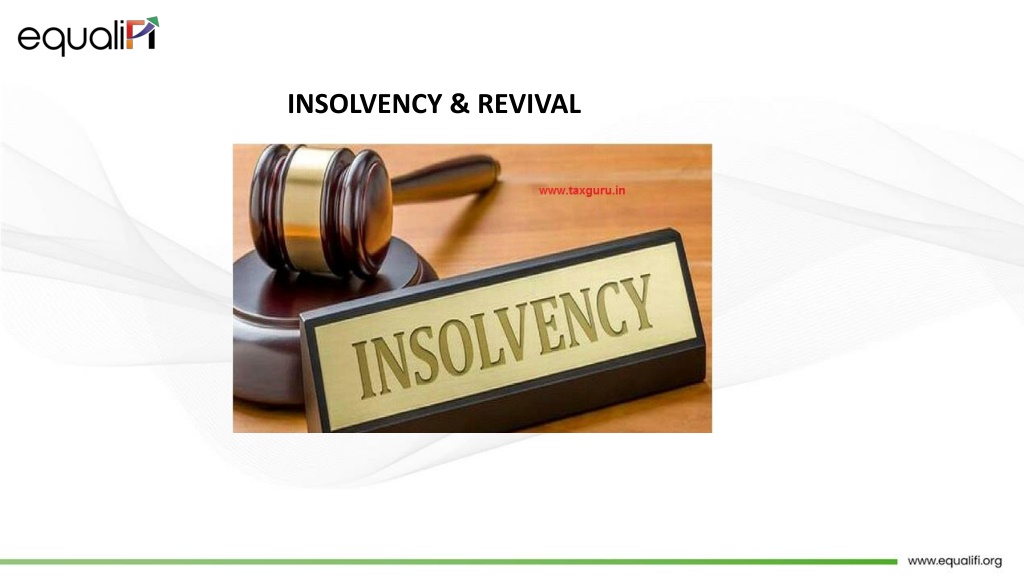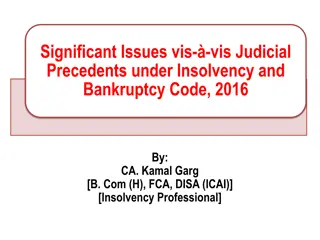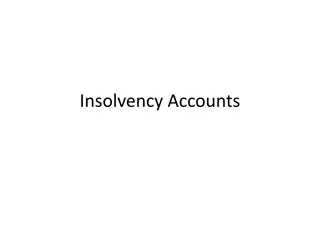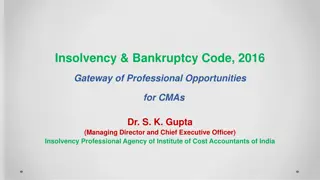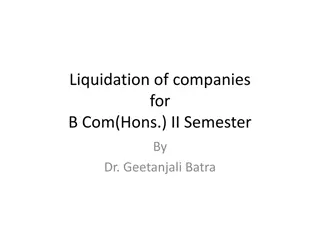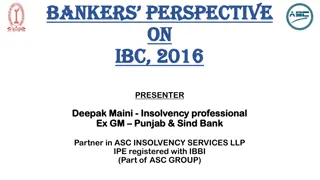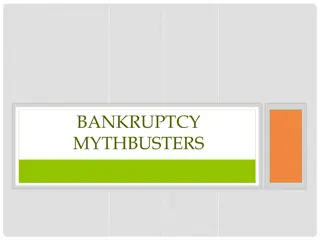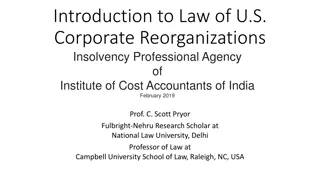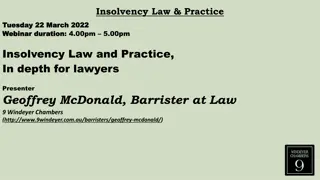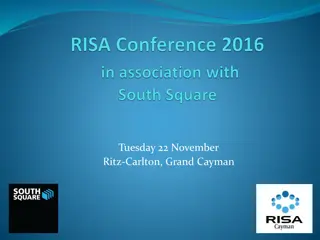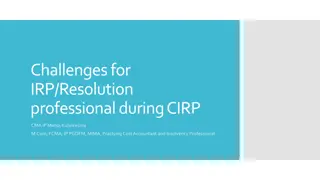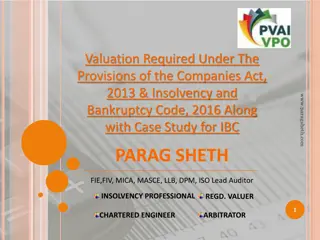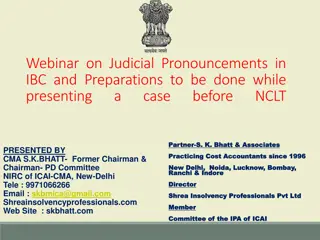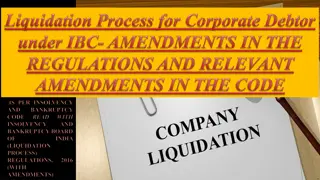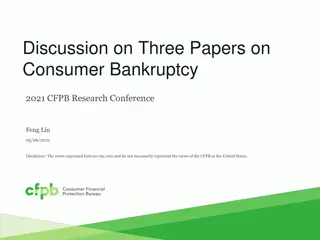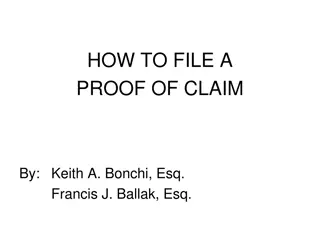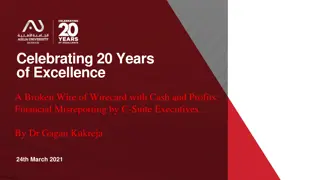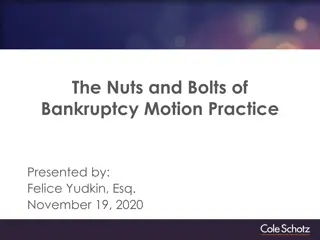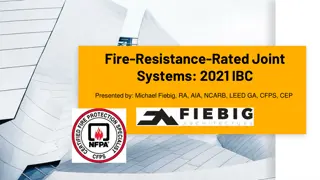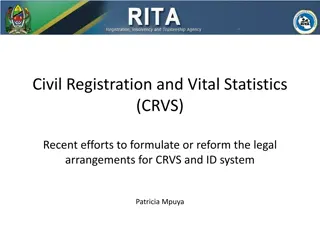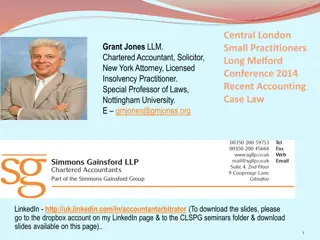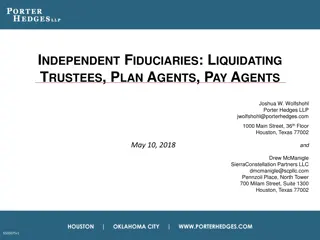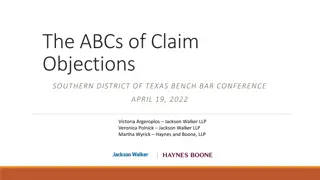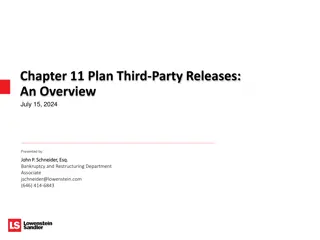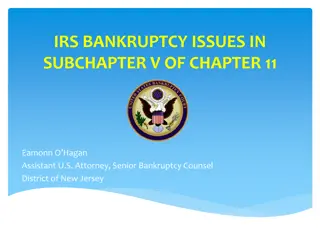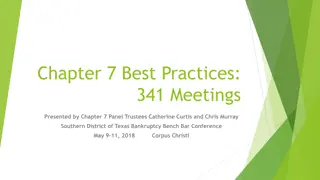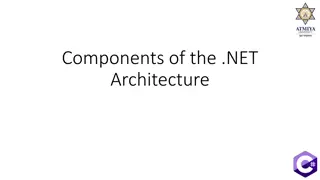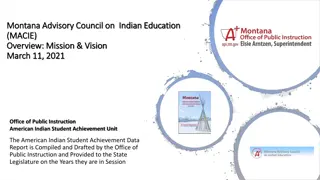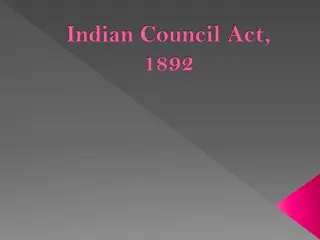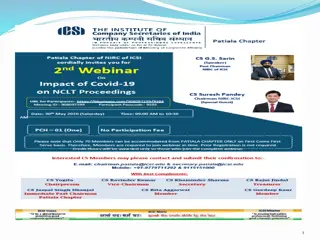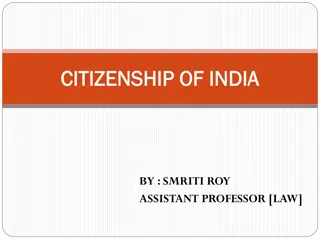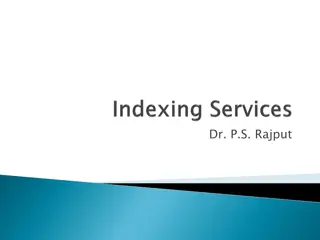Understanding the Indian Bankruptcy and Insolvency Code (IBC) of 2016
The Indian Bankruptcy and Insolvency Code (IBC) of 2016 was introduced to streamline the resolution process for companies and individuals, aiming to improve recovery rates and ranking in insolvency matters. It consolidated existing laws, creating a time-bound framework to handle insolvency cases efficiently. The IBC addressed the challenge of fragmented and prolonged resolution processes by implementing a structured approach. The Code aimed to enhance the overall banking sector resilience and efficiency in dealing with stressed assets.
Download Presentation

Please find below an Image/Link to download the presentation.
The content on the website is provided AS IS for your information and personal use only. It may not be sold, licensed, or shared on other websites without obtaining consent from the author. Download presentation by click this link. If you encounter any issues during the download, it is possible that the publisher has removed the file from their server.
E N D
Presentation Transcript
Background of IBC 2016 Banks in India were going through unprecedented times with stressed loan portfolio touching all-time high. There was an apprehension that there could be further significant additions as many stressed loan accounts had been disguised as standard. Realizing the problem, RBI had attempted to force banks to clean up balance sheets and come out with many regulatory steps aimed at improving banks ability to deal with such stressed accounts. However, such frameworks have proved unsuccessful. India at that time had multiple laws to deal with insolvency, which lead the entire resolution process fragmented, expensive and time-consuming with very low recovery rate. In this scenario, the Indian Government had introduced the Bankruptcy and Insolvency Code, 2016 which would consolidate the existing frameworks and create a new institutional structure The Code created time-bound processes for insolvency resolution of companies and individuals which thereby would help India improve its World Bank insolvency ranking.
Delinquency Data before IBC 2016 March Gross NPA Ratio (%) Net NPA Ratio (%) Stressed Asset/Advance (%) 2013 3.27 1.72 NA 2014 3.86 2.17 9.75 2015 4.37 2.48 11.01 2016 7.61 4.63 11.5 PSU March Gross NPA Ratio (%) Net NPA Ratio (%) Stressed Asset/Advance (%) 2013 3.59 1.99 NA 2014 4.34 2.53 11.04 2015 4.94 2.9 12.68 2016 9.6 6.1 14.5 Private Banks March Gross NPA Ratio (%) Net NPA Ratio (%) Stressed Asset/Advance (%) 2013 1.86 0.52 NA 2014 1.82 0.63 4.29 2015 2.14 0.87 4.59 2016 2.7 1.3 4.5
Legal framework of IBC 2016 Law/Act Dealt with Presidency Town Insolvency Act, 1909/Provincial Insolvency Act 1920/Indian Partnership Act Applicable to Individuals & Partnerships Companies Act 2013/1956 Deals with rehabilitation / revival / winding up of companies; only court supervised winding up available now under the 2013 Act; other proceedings under the Code Limited Liability Partnership Act, 2008 r/w. Limited Liability Partnership (Winding up and Dissolution) Rules, 2012 SICA No provisions for rehabilitation / revival of LLPs Revival / rehabilitation of only sick industrial companies Debt recovery / enforcement of security No revival / rehabilitation of the defaulting entity SARFAESI / Recovery of Debt Due to Banks and Financial Institutions Act, 1993 CDR , JLF, SDR and S4A Introduced by RBI as out of court process No legal sanction
Objectives of IBC, 2016 To promote entrepreneurship; To make credit available To balance the interest of all stakeholders by consolidating and amending the existing laws relating to insolvency and bankruptcy To reduce the time of resolution for maximizing the value of assets The key theme of the Code is to consolidate all laws relating to insolvency of companies, limited liability entities, unlimited liability partnership and individuals.
Cases ideal for IBC, 2016 When account has become irregular and Bank is of the view that borrower is taking matter casually When there are multiple lenders and (i) Client is keeping account of a few lenders regular but others irregular (ii) When lenders are not able to reach consensus quickly (iii)When certain lenders with senior debt (1st charge holders) or other privileges are dominant and unfair to junior debt (unsecured or 2nd charge holders) (iv)TRA mechanism is not benefitting some lenders in just manner.
Cases ideal for IBC 2016.continued. When security coverage is low or very difficult to realise. When lenders apprehend that the account is likely to go bad and borrower can siphon away funds or strip assets Cases where SARFAESI or RDDB can not be applied, but still the account is showing signs of stress and needs resolution within legal framework When lenders doubt about integrity and/or managerial capabilities of existing promoters When lenders expect genuine interest for change of management
Cost of Insolvency Proceeding COC-Committee of Creditors Cost Head Borne By Remark Rs. 2000 if applicant is operational creditor else 25000 Applicant Application Fee Public Announcement cost Applicant Not to form part of IRP Fixed by Applicant. To be borne by the debtor to the extent ratified by COC Applicant/Debtor IRP Fee Other cost including Valuer s Fees, Forensic Audit Cost, professional advisors appointed by IRP RP Cost Cost of interim finance Applicant/Debtor Debtor Debtor To the extent ratified by COC COC to fix COC to fix limit of interim finance Other Insolvency Resolution Process Cost Debtor To be approved by COC
Advantages of IBC Creditors in control as most decision making with the lenders. Time bound and quick solution for stressed and NPA accounts. Change of management possible. Brings financial lenders to a platform enabling quick decision making and arriving at consensus quickly. Prepare and examine resolution plan by professionals appointed by creditors ensuring fearless decision making Final approval by NCLT (a legal entity) so less stress/fear of accountability/ vigilance. Fair chance to viable and sustainable units for time bound revival. In cases of unviable accounts, faster, transparent and smooth liquidation process Clear and fair distribution of funds in case of liquidation. Government dues to get last priority Protection of assets of secured borrowers with maximisation of realisation. Positive support from government for realisation and resolution of NPAs
SARFAESI Vs IBC SARFAESI doesn t consider revival while IBC first considers revival SARFAESI doesn t provide control with Creditors while IBC provides the same through IRP SARFAESI doesn t provide priority of payment to secured creditors over all Govt and Statutory dues Under SARFAESI physical possession passes on to lenders obligating them to arrange for security and maintenance while under IBC it becomes responsibility of an independent agency. SARFAESI provides exclusive power to secured creditors and also differentiates between 1 st charge and 2nd charge holders while in IBC all financial creditors are considered at par Under IBC quick change of management is possible while under SARFAESI change of ownership / management is possible, but cumbersome. SARFAESI process is more time consuming. Legal/administrative hurdles of involving DM, Local PS and Trade Unions is passed on to independent process.
REVIVAL OF GENERAL MOTORS General Motors is one of the renowned Name in the world of Auto Industry. Some of the famous Brands in India are: Opel Astra Opel Corsa Chevrolet (Tavera, Cruz, Beat)
What went Wrong with GM- some key pointers GM makes cars people don t want GM was too slow to innovate because of its size GM was too bureaucratic and unable to adjust to changing markets GM s dealer network is too large
Steps taken by GM as Remedial Measure: The Company identified the good business units and transferred them to a newly formed company Was able to get $45 bn dollar Govt Funding Agreement with Govt & GM's board to do the new company plan A qualified successor in place- MR. FRITZ Treasury agreed to fully fund the new company with Equity In June 2009, GM filed for bankruptcy in New York, with $82 billion assets & $ 173 billion liabilities largest bankruptcy in the world New GM exited Bankruptcy Protection on July 10, 2009 in a mere 40 days The company got its fresh start using the new company plan & the industry was saved with Govt funding from both Bush & Obama
